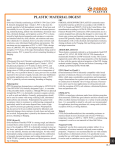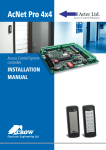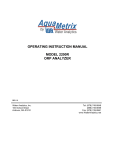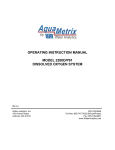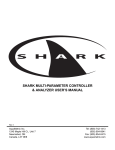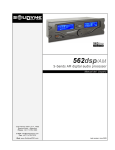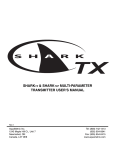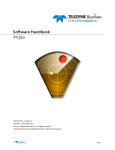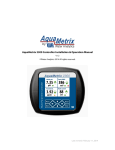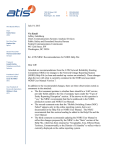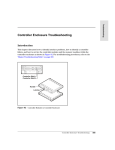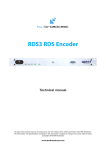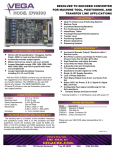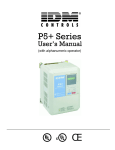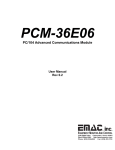Download AquaMetrix 60 Series Differential pH/ORP Sensors
Transcript
OPERATING INSTRUCTION MANUAL MODEL P/R60 & P/R65 DIFFERENTIAL PH & ORP PROBES N116-19 REV. 10 Water Analytics, Inc. 100 School Street Andover, MA 01810 P/R60 & P/R65 Tel: (978) 749-9949 (855) 747-7623 Fax: (978) 749-9961 www.WaterAnalytics.net Page 1 TABLE OF CONTENTS 1.0 GENERAL INFORMATION 4 2.0 SPECIFICATIONS 5 3.0 INSTALLATION 6 3.1 General Instructions 6 3.2 ORP 4-20 mA Probes, R65 6 3.3 Submersion Mounting Series 8 Differential Probes 6 3.4 Submersion Mounting Series 6 Differential Probes 7 3.5 Flow-through tee mounting Series 8 Differential Probes 7 3.6 Flow-through tee mounting Series 6 Differential Probes 7 3.7 Sanitary Probe P60S, P65S, R60S, R65S 7 3.8 Insertion mounting Series 4 Differential Probes 8 3.9 Hot/Wet tap insertion mounting Series 7 Differential Probes 8 4.0 8 SERVICE AND MAINTENANCE 4.1 Probe Cleaning 8 4.2 Replacement of Salt Bridge for Series 4, 6, 7 & S Differential Probes 9 4.3 Replacement of Salt Bridge for Series 8 Differential Probes 9 4.4 Storage 9 5.0 9 TROUBLESHOOTING AND SERVICE 5.1 Checking 5-wire Differential Probes P60 and R60 10 5.2 Checking Probes P65 and R65 (4-20 mA output) 11 5.3 Customer Service 12 5.4 Parts and Accessories 12 5.5 Probe Return 13 6.0 14 DRAWINGS P/R60 & P/R65 Page 2 6.1 N106-61 SERIES 4 DIFFERENTIAL pH/ORP PROBES 14 6.2 N106-183 SERIES 6 DIFFERENTIAL pH/ORP PROBES 15 6.3 N106-184 SERIES 7 DIFFERENTIAL pH/ORP PROBES 16 6.4 N106-182 SERIES 8 DIFFERENTIAL pH/ORP PROBES 17 6.5 N106-62 SERIES S DIFFERENTIAL pH/ORP PROBES 18 6.6 N105-73 INSTALLATION OF SERIES 6 DIFFERENTIAL PROBES 19 6.7 N106-79 INSTALLATION OF SERIES 7 DIFFERENTIAL PROBES 20 6.8 N105-72 INSTALLATION OF SERIES 8 DIFFERENTIAL PROBE 21 6.9 N106-60 INSTALLATION OF SALT BRIDGE IN A DIFFERENTIAL PROBE 22 7.0 SENSOR WARRANTY P/R60 & P/R65 ERROR! BOOKMARK NOT DEFINED. Page 3 1.0 GENERAL INFORMATION This manual covers all AquaMetrix P60, P65, R60 and R65 Series differential measurement pH and ORP probes. All mounting configurations are described. Both those probes with encapsulated preamplifiers and those with encapsulated two-wire transmitters are covered. If your probe has five wires it has an encapsulated preamplifier (P60 and R60). If your probe has two wires, or in the case of an ORP probe four wires, it has an encapsulated two-wire transmitter (P65 and R65). The output from a two-wire transmitter type is non-isolated and un-calibrated. The system must provide 24 Vdc, with “low” isolated from earth ground, and a means of calibrating for offset and span. NOTE: Do not discard the protective cap(s) that came with the sensor. If the sensor is removed from the process for an extended period of time, thoroughly clean the sensor, put a piece of cotton ball with few drops of water into the protective cap and replace it on the sensor. This keeps the junction from drying out which causes slow response when put back into operation or causes permanent damage to the sensor. Sensors should not be left in dry lines or empty tanks for extended periods. Do not store the sensors in a dry or humid location. When storing, check the protective cap(s) regularly to make sure the cotton ball remains moist. Improper storage of sensors voids the warranty. P/R60 & P/R65 Page 4 2.0 SPECIFICATIONS MEASURING RANGES: pH: 0 to 14.00 pH ORP: R60: +1999 mV R65: 0-1000 mV / +500 mV field selectable PRESSURE LIMIT: 100 psig @ 65°C 40 psig @ 95°C FLOW RATE: 10 ft./sec max. Flow should be as low as possible in low conductivity water and in solutions with high suspended solids POWER SUPPLY LIMIT: 24VDC ± 4V WETTED MATERIALS: P60/P65: CPVC, kynar/ceramic, glass, titanium palladium alloy and EPDM R60/R65: CPVC, kynar/ceramic, glass, titanium palladium alloy, EPDM, and platinum AUTOMATIC TEMPERATURE COMPENSATION: -5 to 95°C (23 to 203°F) TRANSMISSION DISTANCE: 5-wire Probes: 900 meters (3000 ft.) 2-wire Probes: Limited only by cable resistance and voltage of power supply SENSITIVITY: pH: Less than 0.005 pH ORP: Less than 0.5mV STABILITY: 0.03 pH / 2mV per day, non-cumulative P/R60 & P/R65 TEMPERATURE LIMITS: -5 to 95°C (23 to 203°F) PROBE CABLE: 15 ft. (4.6 m) P65C: OUTPUT SPAN: 1.14mA / pH OUTPUT OFFSET: 12mA @ 7pH +1.14mA MAX LOAD: 450 Ohms R65C: OUTPUT SPAN: 0-1000mV: 1.6mA / 100mV +500mV: 1.6mA / 100mV OUTPUT OFFSET: 0-1000mV: 12mA @ 500mV +1mA +500mV: 12mA @ 0mV +1mA MAX LOAD: 450 Ohms Page 5 3.0 INSTALLATION 3.1 General Instructions 3.1.1 Specific instructions for each type of probe are given in the following pages. Common to all probes are the following instructions: a) If the distance between the probe and the instrument is such that a direct connection is not possible, the probe cable should be routed to a junction box with a terminal strip (AquaMetrix Part No. JB1). The box should be well sealed and away from corrosion danger. Be sure that you have sufficient slack cable to allow for probe removal for calibration and servicing. b) Route the interconnect cable from the junction box to the instrument, preferably in metal conduit. Do not run the power cable or control cables in the same conduit with the probe interconnect cable. c) Remove the protective plastic caps from the end of the probe before placing in service. d) For best results probes should always be mounted vertically with electrodes down. If this is not possible, the probe must be at least 15° above horizontal. 3.2 ORP 4-20 mA Probes, R65 3.2.1 a) ORP 4-20 mA probes have four wires; black, red, green and white. The red wire is to be connected to the +24 Vdc terminal and the back wire to the 24 Vdc common terminal via the load in the loop. b) For an instrument with a range of 0 to 1000 mV the green and white wires are to be shorted. c) For an instrument with a range of –500 to 500 mV the green and white wires are to be isolated from each other. 3.3 Submersion Mounting Series 8 Differential Probes Refer to Dwg# N105-72 3.3.1 a) A submersion mounting kit, STC60L is available from Water Analytics which includes 4 ft. of 1” pipe, 1-1/2” x 1” reducer, a strain relief fitting and wire mounting bracket. Proceed as follows, either with the kit or with your own hardware. b) Apply a thread sealant to the thread on the cable end of the probe and screw a 1-1/2” x 1” NPT reducer onto the probe. Route the sensor cable through an appropriate length of 1” pipe and using thread sealant, screw the pipe into the reducer. The cable end of the probe should not be exposed to the process. A cable strain relief fitting should be used on the upper end of the pipe. In the kits a wire bracket is provided to aid in supporting the assembly. NOTE: An optional protective shroud, Part No. PROTECTOR-3 should be used on the electrode end of the probe to protect the electrodes from accidental contact with the tank bottom, sides or objects in the process. P/R60 & P/R65 Page 6 3.4 Submersion Mounting Series 6 Differential Probes Refer to Dwg# N105-73 3.4.1 a) A submersion mounting kit, STC60-6 is available from Water Analytics which includes 4 ft. of 1” pipe, 1-1/2” x 1” reducer and a strain relief fitting. Proceed as follows, either with the kit or with your own hardware: b) Install the optional protective shroud, Part No. PROTECTOR-6 on the probe by threading the probe cable through it. The shroud will contact the shoulder on the probe. c) Install the compression fitting components on the probe in the order shown in the drawing below so that the pipe thread is towards the cable end of the probe. If you are concerned that the shroud may get pushed up and expose the electrodes you can lock it down by the positioning of the fittings. d) Snug up the nut of the compression fitting to locate it in the desired position. Hand tighten as much as possible, then turn 1/2 turn with a wrench. e) Apply a thread sealant to the pipe thread portion of the compression fitting and screw a 1-1/4” x 1” NPT reducer to it. f) Route the sensor cable through an appropriate length of 1” pipe and using thread sealant, screw the pipe into the reducer on the probe. The cable end of the probe should not be exposed to the process. 3.5 Flow-through tee mounting Series 8 Differential Probes Refer to Dwg# N105-72 3.5.1 a) Apply pipe sealant to the electrode end of the probe and screw it into the AquaMetrix union tee w/ adaptor (Part No. AM-MH538N9A) or any standard 11/2” NPT tee. 3.6 Flow-through tee mounting Series 6 Differential Probes Refer to Dwg# N105-73 3.6.1 a) Take the compression fitting apart. Apply pipe sealant to the 1-1/4” NPT thread and screw this part into a 1-1/4” tee. A larger tee with an appropriate reducer may be used. b) Put the compression fitting components on the probe in the order shown in the drawing. They should be in such a position that the electrodes will be in the pipe stream but not touching the opposite side of the tee. c) Remove the protective cap from the probe and place the probe in the tee. Now tighten the nut by hand as much as possible, then turn 1/2 turn with a wrench. 3.7 Sanitary Probe P60S, P65S, R60S, R65S 3.7.1 P/R60 & P/R65 The P60S is designed with a stainless steel flange to mate with a Tri-Clover ferrule TL14AM7-2-1/2. Page 7 3.8 Insertion mounting Series 4 Differential Probes 3.8.1 Apply pipe sealant to the electrode end of the probe and screw it into the any standard 1-1/2” Male NPT. 3.9 Hot/Wet tap insertion mounting Series 7 Differential Probes Refer to Dwg# N106-79 3.9.1 a) A ball valve assembly, P60-HTC, is available from Water Analytics which includes the assembly and a safety shroud. b) Mount the ball valve assembly in a desirable location. The assembly comes with a field selectable, 1-1/4 NPTF or socket adaptor. Make sure valve is in the close position before mounting. c) Remove the union body by turning the union nut counter clockwise. Take the compression fitting apart as shown on the drawing. Insert the back end of the series 7 probe through the union body until safety notch on the probe aligns with the safety stop on the union body. d) Place the union body, with the probe attached, back into the ball vale assembly and tighten union nut. Open ball valve & slide the probe into the process. e) Put the compression fitting components on the probe in the order shown in the drawing and tighten the nut by hand as much as possible, then turn 1/2 turn with a wrench to keep probe in place. f) 4.0 Insert protective shroud as shown. SERVICE AND MAINTENANCE 4.1 Probe Cleaning 4.4.1 a) The probe should be kept reasonably clean to avoid measurement errors. Frequency of cleaning can only be determined by experience. To clean proceed as follows: b) Rinse with clean warm water. c) Soak the end of the probe in warm water and dish detergent for 3 or 4 minutes. d) Brush the end of the probe, particularly the three electrodes with a soft bristle brush such as a tooth brush. Take care not to scratch the glass electrode. e) If the probe is still not clean, it may have to be cleaned with acid. CAUTION: Do not acid clean probes used in processes containing cyanide solutions. Some experimentation may be required to determine the most suitable acid for your process. Use the most dilute acid which is effective. Normally 10 parts of water to one part muriatic acid is sufficient. Do not use hydrofluoric acid. f) Soak the probe for not more than 5 minutes in the chosen acid; then rinse thoroughly with clean warm water and soak in water for 3-5 minutes. g) Calibrate the system in accordance with the instrument instruction manual. P/R60 & P/R65 Page 8 4.2 Replacement of Salt Bridge for Series 4, 6, 7 & S Differential Probes 4.2.1 a) If the system cannot be calibrated after cleaning the probe, it may be necessary to replace the standard cell solution. A kit is available from Water Analytics for this purpose (Part No. C35-17K). Proceed as follows: Refer to DWG N106-60. b) Hold the probe vertically with the sensor face up. Insert long nose pliers in the blind holes in the salt bridge and turn counter-clockwise taking care not to damage the glass electrode. Discard the used salt bridge. c) Up-end the probe and pour out the contents of the standard electrode chamber. Flush the chamber with a small amount of pH 7 buffer or clean water. d) Refill the chamber with 7pH buffer solution up to the tip of the electrode inside the chamber. DO NOT OVERFILL. It is important to leave space for the salt bridge thread and a small amount of air. e) Screw the new salt bridge into the cavity until finger tight. Now turn 1/4 turn with long nose pliers. The front face of the salt bridge should be flush with the probe face. 4.3 Replacement of Salt Bridge for Series 8 Differential Probes 4.3.1 a) If the system can’t be calibrated after cleaning the probe, it may be necessary to replace the standard cell solution. A kit is available from Water Analytics for this purpose (Part No. AM60-9765K). Proceed as follows: Refer to DWG N10660. b) Hold the probe vertically electrodes up. Remove the used salt bridge using a 9/16” socket wrench, turning counter-clockwise. Discard the used salt bridge. c) Dispose of the used solution inside the bridge chamber and flush with pH 7 solution or distilled water. d) Refill the chamber with 7pH buffer solution, up to the tip of the electrode, inside the chamber. DO NOT OVERFILL. It is important to leave space for the salt bridge thread and a small amount of air. e) Screw the new salt bridge into the cavity until finger tight. Now perform a 1/4 turn with a 9/16” socket wrench. The salt bridge edges should be flush with the front of the probe face. 4.4 Storage 4.4.1 Do not discard the protective cap(s) that came with the sensor. If the sensor is removed from the process for an extended period of time, thoroughly clean the sensor, put a piece of cotton ball with few drops of water into the protective cap and replace it on the sensor. This keeps the junction from drying out which causes slow response when put back into operation or causes permanent damage to the sensor. Sensors should not be left in dry lines or empty tanks for extended periods. Do not store the sensors in a dry or humid location. When storing, check the protective cap(s) regularly to make sure the cotton ball remains moist. Improper storage of sensors voids the warranty. 5.0 TROUBLESHOOTING AND SERVICE P/R60 & P/R65 Page 9 5.1 Checking 5-wire Differential Probes P60 and R60 The probe can be checked by a few simple measurements. Two pH buffer solutions, 7 pH and either 4 pH or 10 pH, and a multimeter are required. For ORP probes two calibration solutions, 200 and 600 mV, are required. Millivolt solutions may be ±20% of nominal value. Actual value is noted on the bottle. 5.1.1 P60C pH probes a) Clean the probe as described in Section 4.1. If the system cannot be calibrated, replace the salt bridge and 7pH buffer solution as described in 4.2. If the system still can’t be calibrated check the probe as follows: b) Disconnect red, green, yellow and black wires at the junction box. If you are not using a junction box, disconnect at the instrument after shutting off the power. c) Place the probe in 7 pH buffer. Allow enough time for the temperature of the probe and buffer to stabilize at room temperature. d) Measure the resistance between the yellow and black wires to check the probe’s temperature compensator. The resistance should be between 250 and 350 ohms at 25°C. If the resistance is within specifications the probes thermistor is functioning correctly. e) Reconnect the yellow and black wires and restore power to the instrument. f) Measure the voltage between the red and green wires. If it is not within –50 to +50 millivolts with the probe in 7 pH buffer, the probe is defective. If the voltage is OK proceed to the next step. g) Rinse the probe and place it in 4 pH or 10 pH buffer. Allow it to stabilize then check the voltage again between the red and green wires. If the voltage is between 100 and 230 millivolts (negative in 10 pH buffer, positive in 4 pH buffer) the probe is within specifications. 5.1.2 R60C ORP probes a) Clean the probe as described in Section 4.1. If the system cannot be calibrated, replace the salt bridge and 7pH buffer solution as described in 4.2. If the system still can’t be calibrated check the probe as follows: b) Disconnect red, green, yellow and black wires at the junction box. If you are not using a junction box, disconnect at the instrument after shutting off the power. c) Place the probe in 200 mV solution. Allow enough time for the temperature of the probe and solution to stabilize at room temperature. d) Measure the resistance between the yellow and black wires to check the probe’s temperature compensator. The resistance should be between 250 and 350 ohms at 25°C. If the resistance is within specifications the probes thermistor is functioning correctly. e) Reconnect the yellow and black wires and restore power to the instrument. P/R60 & P/R65 Page 10 f) Measure the voltage between the red and green wires. The reading should be between 160 and 240 mV; otherwise, the probe is defective. If the voltage is OK proceed to the next step. g) Rinse the probe and place it in 600 mV solution. Allow it to stabilize then check the voltage again between the red and green wires. If the voltage is between 560 and 640 mV, the probe is within specifications. 5.2 Checking Probes P65 and R65 (4-20 mA output) The operation of the 2-wire, 4-20 mA, probe can be checked by a few simple measurements. Two pH buffer solutions, 7 pH and either 4 pH or 10 pH, and a dc milliammeter are required. 5.2.1 P65C pH Probe a) Disconnect the red wire at the instrument or power supply and connect it to the milliammeter (-) black. b) Connect the milliammeter (+) red to the instrument or power supply red wire output terminal. c) Rinse the probe and place it in 7 pH buffer. Allow the temperature of the buffer and probe to stabilize at room temperature. d) Check the offset of the probe by reading the milliammeter. The reading should be between 11 and 13 mA. If not the probe is defective. If the offset is OK, note the exact reading and proceed to the next step. e) Rinse the probe and place it in 4 pH or 10 pH buffer. Allow the temperature of the probe and buffer to stabilize at room temperature. Now check the span of the probe by reading the milliammeter. If the probe is in 4 pH buffer, the reading should be between 2.85 and 3.99 lower than the reading obtained in (d). If the probe is in 10 pH buffer, the reading should be between 2.85 and 3.99 higher than the reading obtained in (d). If this test is not satisfied the probe is defective. If you wish to check the temperature compensator proceed to step (f). If the span of the probe drops below 2.85mA than the probe still can be used adjustments will have to be made to the receiving device to compensate for the low span. f) P/R60 & P/R65 To check the operation of the temperature sensor in the probe, heat the buffer used in step (e) with the probe in it to about 50°C. The milliammeter reading should be within ±0.15 mA of the reading observed in step (e). Page 11 5.2.2 ORP Probes R65 a) Disconnect the red wire at the instrument or power supply and connect it to the milliammeter (-) black. Connect the milliammeter (+) red to the instrument or power supply red wire output terminal. b) For a probe with range of –500 to 500 mV: (white and green wire open). Rinse the probe and place it in the 200 mV solution. The milliammeter should read between 14.4 and 16.0 mA. Rinse the probe and place it in the 600 mV solution. The meter should read between 19.55 and 20.45 mA. c) For a probe with range of 0 to 1000 mV: (white and green wire joined). Rinse the probe and place it in the 200 mV solution. The milliammeter should read between 6.4 and 8.0 mA. Rinse the probe and place it in the 600 mV solution. The meter should read between 12.8 and 14.4ma. 5.3 Customer Service 5.3.1 If a problem has not been resolved with the above procedures, a telephone consultation with your AquaMetrix representative, or directly with Water Analytics will provide the answer. Water Analytics Inc. 100 School Street Newmarket, Ontario Tel: (888) 749-9099 Tel: (978) 749-9949 Toll Free: (855) 747-7623 Fax: (978) 978-9961 Email: [email protected] 5.4 Parts and Accessories Description Submersion Mounting Kit for Series –8 Probes Submersion Mounting Kit for Series –6 Probes Protective shroud for Series –8 Probes Protective shroud for Series –6 Probes Hot/Wet tap Ball Valve Assembly for Series –7 Union Mounting Tee w/ Adaptor for Series –8 500 mL pH 7 Buffer Solution 4L pH 7 Buffer Solution 500 mL pH 4 Buffer Solution 4L pH 4 Buffer Solution 500 mL pH 10 Buffer Solution 4L pH 10 Buffer Solution 500 mL 200mV Buffer Solution 4L 200mV Buffer Solution 500 mL 600mV Buffer Soltion 4L 600mV Buffer Solution Salt bridge kit for Series –4, –6, –7 & –S (Package of 3, incl. salt bridge and cell solution) Salt bridge kit for Series –8 (Package of 3, incl. salt bridge and cell solution) Junction box with terminal strip 50 ft. 5-wire Interconnect cable dressed both ends P/R60 & P/R65 Part # STC60L STC60-6 PROTECTOR-3 PROTECTOR-6 P60-HTC AM-MH538N9A A35-14 A35-118 A35-13 A35-117 A35-24 A35-119 A35-40 A35-115 A35-41 A35-116 C35-17(K) AM60-9765(K) JB-1 C42-5P-050 Page 12 5.5 Probe Return 5.5.1 If you are returning a probe for inspection, enclose description of the problem. Pack the probe adequately to avoid damage to the glass electrode and ensure that it will not be exposed to temperatures below –5°C. Water Analytics cannot be responsible for shipping damage nor for damage due to frozen electrodes. For safety reasons, Water Analytics cannot accept probes which have not been thoroughly cleaned to remove all process material. P/R60 & P/R65 Page 13 6.0 DRAWINGS 6.1 N106-61 SERIES 4 DIFFERENTIAL pH/ORP PROBES P/R60 & P/R65 Page 14 6.2 N106-183 SERIES 6 DIFFERENTIAL pH/ORP PROBES P/R60 & P/R65 Page 15 6.3 N106-184 SERIES 7 DIFFERENTIAL pH/ORP PROBES P/R60 & P/R65 Page 16 6.4 N106-182 SERIES 8 DIFFERENTIAL pH/ORP PROBES P/R60 & P/R65 Page 17 6.5 N106-62 SERIES S DIFFERENTIAL pH/ORP PROBES P/R60 & P/R65 Page 18 6.6 N105-73 INSTALLATION OF SERIES 6 DIFFERENTIAL PROBES P/R60 & P/R65 Page 19 6.7 N106-79 INSTALLATION OF SERIES 7 DIFFERENTIAL PROBES P/R60 & P/R65 Page 20 6.8 N105-72 INSTALLATION OF SERIES 8 DIFFERENTIAL PROBE P/R60 & P/R65 Page 21 6.9 N106-60 INSTALLATION OF SALT BRIDGE IN A DIFFERENTIAL PROBE P/R60 & P/R65 Page 22























